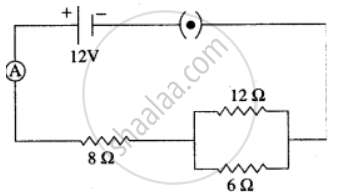Advertisements
Advertisements
Question
A current of 0.2 A flows through a wire whose ends are at a potential difference of 15 V. Calculate:
(i) The resistance of the wire, and
(ii) The heat energy produced in 1 minute.
Solution
Given, current, I= 0.2 A; p.d. = 15 V
(i) A/C to Ohm's law
V=IR
R = `"v"/"I" = 15/0.2 = 75 Omega`
(ii) energy produced in one minutes is:
H=I2 Rt = (0.2)2 x 75 x 60 =180 J
APPEARS IN
RELATED QUESTIONS
State two causes of energy loss in a transformer.
A potential difference of 20 volts is applied across the ends of a resistance of 5 ohms. What current will flow in the resistance?
What p.d. is needed to send a current of 6 A through an electrical appliance having a resistance of 40 Ω?
If the potential difference between the ends of a fixed resistor is halved, the electric power will become:
Point out two differences between e.m.f. and potential difference as applied to electric circuits.
Three resistors are connected to a 12 V battery as shown in the figure given below:

(i) What is the current through the 8 ohm resistor?
(ii) What is the potential difference across the parallel combination of 6 ohm and 12 ohm resistor?
(iii) What is the current through the 6 ohm resistor?
A cell of e.m.f 2.0 V and internal resistance 1Ω is connected to the resistors of 3Ω and 6Ω in series. Calculate:
(i) the current drawn from the cell,
(ii) the p.d. across each resistor,
(iii) the terminal voltage of the cell and
(iv) the voltage drop.
Exercise.
Calculate the amount of charge that would flow in 2 hours through an element of an electric bulb drawing a current of 2.5 A.
How will you conclude that the same potential difference (voltage) exists across three resistors connected in a parallel arrangement to a battery?
Twenty-seven drops of same size are charged at 220 V each. They combine to form a bigger drop. Calculate the potential of the bigger drop.
